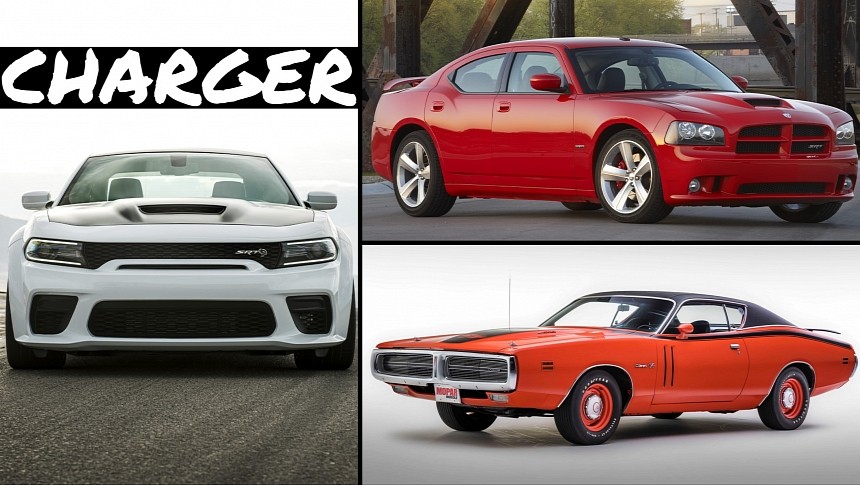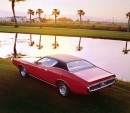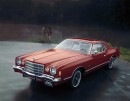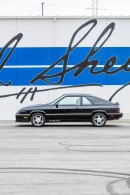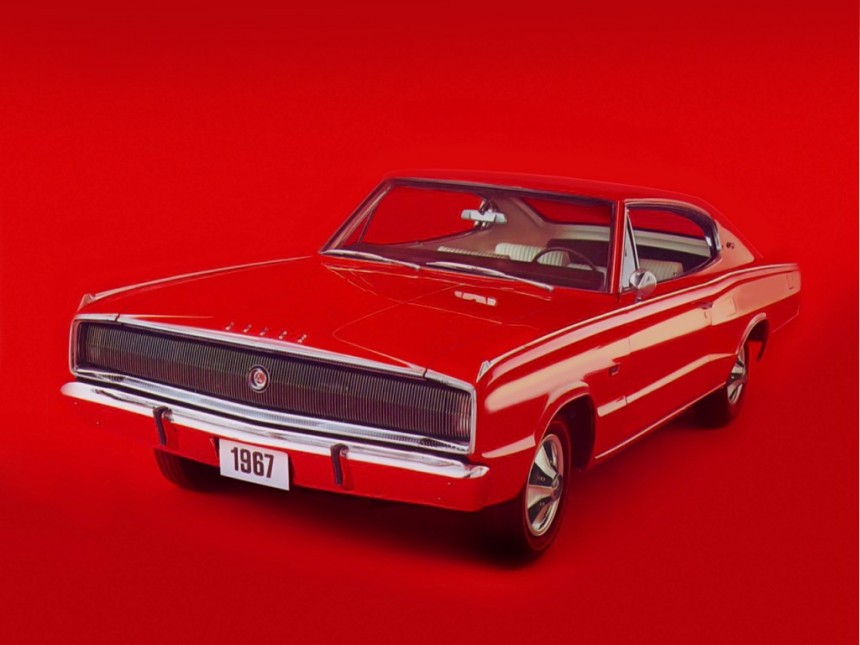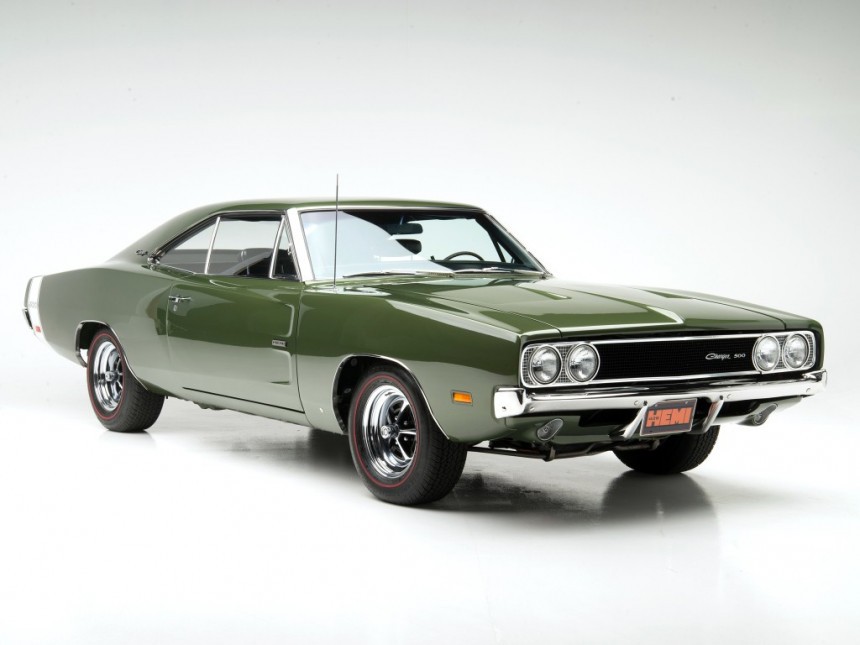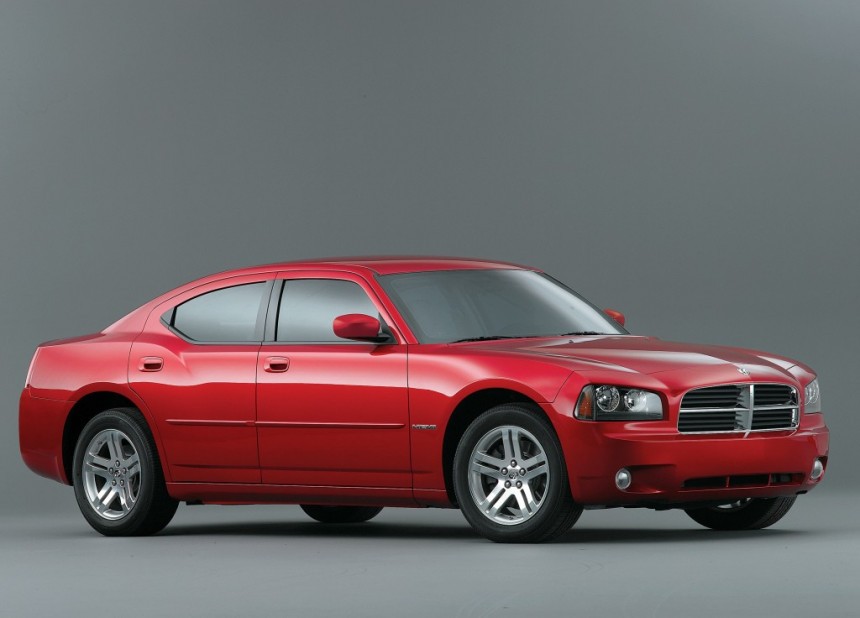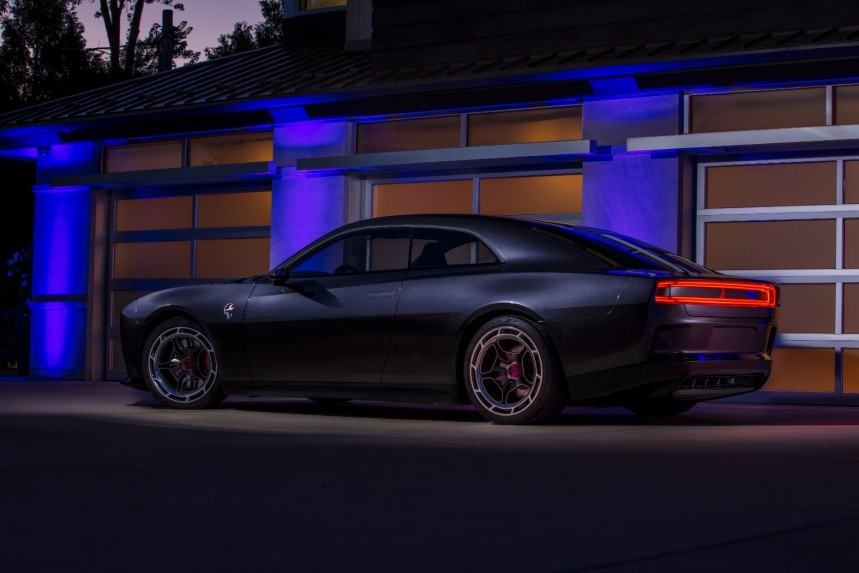Chrysler had a slight issue in the middle of the 1960s, that issue being the lack of a high-performance car of intermediate dimensions. Think of the Pontiac GTO, which disregarded GM’s policy that limited the A-body intermediate line to a maximum of 330 cubic inches (5.4 liters). Given these circumstances, the third-largest automaker of the Big Three in Detroit couldn’t sit idly…
Stylistically inspired by a couple of concepts, the series-production Charger made its debut with much pomp and circumstance in 1966. The first generation is twinned with the mid-sized Coronet in two ways. First and foremost, both feature the B-body platform introduced by the Dart in 1962 and discontinued in 1974. Secondly, the sheet metal up front resembles the Coronet as well.
Gifted with a swept roofline, the original Charger was exclusively offered in the form of a two-door fastback. Chrysler paid attention to the interior design as well. Then headquartered in Highland Park, the company that made the hemispherical combustion chamber its high-performance trademark also paid attention to practicality in the guise of rear seats that could be folded to create additional space for long items. Penned by Carl Cameron, the first generation also stands out in the crowd thanks to an electric shaver-like pot metal grille.
The first Chrysler group series-production car to boast fully rotating headlights since the 1942 model year DeSoto line, the Charger also impressed back in the day with its electroluminescent gauges. Prospective customers were presented with V8s only, beginning with 318-ci and 361-ci lumps featuring two-barrel carbs. The 383 leveled up to four, and finally, the street-oriented Hemi topped the lineup with 426 cubic inches on deck.
With 425 horsepower and 490 pound-feet (664 Nm) to its name, the Hemi was the most desirable and expensive choice of the bunch. Merely 486 units were produced for the 1967 model year out of a total of 37,344 vehicles. 1967 saw the introduction of the 440 as the replacement for the 361, rated at 375 horsepower and 480 pound-feet (651 Nm) of torque. Changes further include a folding armrest that doubled as a seat, a more traditional center console, a vinyl roof, and the R/T package. The 1967, however, flopped in terms of sales.
The 1968 to 1970 model year Dodge Charger is the one we all know and lust after. Remember the R/T 440 from Bullitt and the modified Chargers from the Fast & Furious franchise? What about General Lee from The Dukes of Hazzard? Indeed, the second generation is the Charger that elevated this nameplate to iconic status.
Still based on the B-body vehicle architecture, the second generation features hidden headlights just like its predecessor, although now featuring vacuum-operated covers instead of an electric motor. Styling vice prez Elwood P. Engel is credited with replacing the full-width taillights for circular units. The second generation also rocks two scallops on each side, plus a scalloped hood.
Slightly downscaled in terms of interior appointments, the 1968 to 1970 model year Dodge Charger was offered with one straight-six lump and a plethora of eight-cylinder mills. Once again, the 440 from the RB family and the 426 Hemi were the most exciting options available.
A whopping 96,100 were sold in the first year, up from 15,788 for the final year of the first gen. Beautified with coke bottle styling, the Richard Sias-designed Charger received longitudinal taillights for 1969. Building on the racing failure known as the Charger 500, the Charger Daytona launched for 1969 as well. It was succeeded by another famous aero-conscious warrior of that era, namely the Plymouth Superbird for model year 1970.
The Charger Daytona won its first race (Talladega 500), and it was also the first NASCAR racing car to break 200 miles per hour (322 kilometers per hour). But alas, the Charger Daytona racked up six wins in NASCAR to the Superbird’s eight. In the final year of production, the second gen lost its grille divider. It also switched to electric headlight covers, and 1970 also introduced the 440 Six Pack of the Super Bee and Road Runner, named this way because it uses three two-barrel carburetors.
Widely regarded as the two-door sibling of the Coronet, the third generation is a bit of a hit-and-miss. Even though it sold well, the Charger from this particular epoch was hampered by tighter emission regulations and those nasty 5-mph (8-kph) bumpers. Chrysler also had to downtune the Charger’s engine choices for unleaded gasoline, which is why the automaker preferred to discontinue the legendary 426 Hemi to save its legacy.
Chrysler further discontinued the 440 Six Pack and Hi-Impact exterior colors after the 1971 model year. The 1971 to 1974 third generation uses vehicle identification numbers beginning with the letter W, just like the Coronet. The Charger was redesigned for 1975 into a… wait for it… personal luxury car. A good representation of the Malaise Era, the fourth generation was canned after 1978 in favor of the even duller Dodge Magnum.
Chrysler made things worse with the L-body Charger that ran between 1981 and 1987. The L platform is front-wheel drive by design, and worse still, compared to previous Chargers, it traces its roots back to a 1960s econobox developed by French automaker Simca with Chrysler’s financial backing. The only high point of this generation of the Charger is the Carroll Shelby-prepped GLH-S that packs 175 ponies and 175 pound-feet (237 Nm) of twist from a 2.2-liter turbo four-cylinder mill.
The final wrong-wheel-drive Charger rolled off the assembly line in 1987. Nearly two decades later, Chrysler brought the Charger back with Daimler’s help on a rear-wheel-drive platform dubbed LX. A handful of components were derived from the W211 E-Class and W220 S-Class for the LX vehicle architecture, which is shared with the Magnum wagon, Challenger coupe, and 300 sedan. The Magnum and its Chrysler 300 Touring twin are long gone, though, due to terribly poor sales.
The Charger returned with a vengeance for the 2006 model year, featuring old-school design influences and four doors rather than two. It was a stroke of genius to reimagine it as a sedan, with Dodge moving a whopping 119,289 units during calendar year 2007. Chrysler also made a case for all-wheel drive for the base V6 engine.
V8 options initially comprised the 5.7- and 6.1-liter HEMI, spelled with uppercase letters because that’s how the third-gen engine family is advertised by the Auburn Hills-based automaker. Updated for 2011, the Charger dropped the 6.1er in favor of the 6.4-liter HEMI for the SRT8, SRT 392, and R/T Scat Pack variants. As far as the oily bits are concerned, the 6.2-liter supercharged V8 known as the Hellcat takes the cake with 707 horsepower and 650 pound-feet (881 Nm) for the 2015 model year.
2023 is the final model year for the internal combustion-engined Charger, and the ultimate expression of the muscly sedan is the SRT Hellcat Redeye due to a simply ridiculous 807 horsepower and 707 pound-feet (959 Nm). Production of LX-based vehicles will end at the Brampton assembly plant in 2024. The facility will be retooled for a new and flexible vehicle platform that will support the automaker’s electrification plans. The all-electric Jeep Recon is expected to be produced there.
The Windsor sister plant is understood to make STLA Large-based vehicles, beginning with the all-new and all-electric Charger. Previewed by the Charger Daytona SRT concept back in August 2022, the newcomer is a three-door throwback to the second-generation muscle car. Although it won’t boast the aural qualities of its highly desirable predecessor, the all-electric coupe can get as loud as a Hellcat-powered Dodge Charger thanks to the so-called Fratzonic chambered exhaust system.
An amplifier and a tuning chamber enable artificial exhaust sounds as loud as 126 decibels, which is rock concert-like loud. Both rear- and all-wheel-drive versions will be offered, along with 400- and 800-volt electrical architectures. At press time, confirmed output levels range from 455 to 670 horsepower for the 400-volt system. Output ratings for the 800-volt “SRT Banshee” powertrain sadly aren’t available just yet.
Gifted with a swept roofline, the original Charger was exclusively offered in the form of a two-door fastback. Chrysler paid attention to the interior design as well. Then headquartered in Highland Park, the company that made the hemispherical combustion chamber its high-performance trademark also paid attention to practicality in the guise of rear seats that could be folded to create additional space for long items. Penned by Carl Cameron, the first generation also stands out in the crowd thanks to an electric shaver-like pot metal grille.
The first Chrysler group series-production car to boast fully rotating headlights since the 1942 model year DeSoto line, the Charger also impressed back in the day with its electroluminescent gauges. Prospective customers were presented with V8s only, beginning with 318-ci and 361-ci lumps featuring two-barrel carbs. The 383 leveled up to four, and finally, the street-oriented Hemi topped the lineup with 426 cubic inches on deck.
With 425 horsepower and 490 pound-feet (664 Nm) to its name, the Hemi was the most desirable and expensive choice of the bunch. Merely 486 units were produced for the 1967 model year out of a total of 37,344 vehicles. 1967 saw the introduction of the 440 as the replacement for the 361, rated at 375 horsepower and 480 pound-feet (651 Nm) of torque. Changes further include a folding armrest that doubled as a seat, a more traditional center console, a vinyl roof, and the R/T package. The 1967, however, flopped in terms of sales.
The 1968 to 1970 model year Dodge Charger is the one we all know and lust after. Remember the R/T 440 from Bullitt and the modified Chargers from the Fast & Furious franchise? What about General Lee from The Dukes of Hazzard? Indeed, the second generation is the Charger that elevated this nameplate to iconic status.
Still based on the B-body vehicle architecture, the second generation features hidden headlights just like its predecessor, although now featuring vacuum-operated covers instead of an electric motor. Styling vice prez Elwood P. Engel is credited with replacing the full-width taillights for circular units. The second generation also rocks two scallops on each side, plus a scalloped hood.
Slightly downscaled in terms of interior appointments, the 1968 to 1970 model year Dodge Charger was offered with one straight-six lump and a plethora of eight-cylinder mills. Once again, the 440 from the RB family and the 426 Hemi were the most exciting options available.
A whopping 96,100 were sold in the first year, up from 15,788 for the final year of the first gen. Beautified with coke bottle styling, the Richard Sias-designed Charger received longitudinal taillights for 1969. Building on the racing failure known as the Charger 500, the Charger Daytona launched for 1969 as well. It was succeeded by another famous aero-conscious warrior of that era, namely the Plymouth Superbird for model year 1970.
The Charger Daytona won its first race (Talladega 500), and it was also the first NASCAR racing car to break 200 miles per hour (322 kilometers per hour). But alas, the Charger Daytona racked up six wins in NASCAR to the Superbird’s eight. In the final year of production, the second gen lost its grille divider. It also switched to electric headlight covers, and 1970 also introduced the 440 Six Pack of the Super Bee and Road Runner, named this way because it uses three two-barrel carburetors.
Widely regarded as the two-door sibling of the Coronet, the third generation is a bit of a hit-and-miss. Even though it sold well, the Charger from this particular epoch was hampered by tighter emission regulations and those nasty 5-mph (8-kph) bumpers. Chrysler also had to downtune the Charger’s engine choices for unleaded gasoline, which is why the automaker preferred to discontinue the legendary 426 Hemi to save its legacy.
Chrysler further discontinued the 440 Six Pack and Hi-Impact exterior colors after the 1971 model year. The 1971 to 1974 third generation uses vehicle identification numbers beginning with the letter W, just like the Coronet. The Charger was redesigned for 1975 into a… wait for it… personal luxury car. A good representation of the Malaise Era, the fourth generation was canned after 1978 in favor of the even duller Dodge Magnum.
Chrysler made things worse with the L-body Charger that ran between 1981 and 1987. The L platform is front-wheel drive by design, and worse still, compared to previous Chargers, it traces its roots back to a 1960s econobox developed by French automaker Simca with Chrysler’s financial backing. The only high point of this generation of the Charger is the Carroll Shelby-prepped GLH-S that packs 175 ponies and 175 pound-feet (237 Nm) of twist from a 2.2-liter turbo four-cylinder mill.
The final wrong-wheel-drive Charger rolled off the assembly line in 1987. Nearly two decades later, Chrysler brought the Charger back with Daimler’s help on a rear-wheel-drive platform dubbed LX. A handful of components were derived from the W211 E-Class and W220 S-Class for the LX vehicle architecture, which is shared with the Magnum wagon, Challenger coupe, and 300 sedan. The Magnum and its Chrysler 300 Touring twin are long gone, though, due to terribly poor sales.
The Charger returned with a vengeance for the 2006 model year, featuring old-school design influences and four doors rather than two. It was a stroke of genius to reimagine it as a sedan, with Dodge moving a whopping 119,289 units during calendar year 2007. Chrysler also made a case for all-wheel drive for the base V6 engine.
V8 options initially comprised the 5.7- and 6.1-liter HEMI, spelled with uppercase letters because that’s how the third-gen engine family is advertised by the Auburn Hills-based automaker. Updated for 2011, the Charger dropped the 6.1er in favor of the 6.4-liter HEMI for the SRT8, SRT 392, and R/T Scat Pack variants. As far as the oily bits are concerned, the 6.2-liter supercharged V8 known as the Hellcat takes the cake with 707 horsepower and 650 pound-feet (881 Nm) for the 2015 model year.
2023 is the final model year for the internal combustion-engined Charger, and the ultimate expression of the muscly sedan is the SRT Hellcat Redeye due to a simply ridiculous 807 horsepower and 707 pound-feet (959 Nm). Production of LX-based vehicles will end at the Brampton assembly plant in 2024. The facility will be retooled for a new and flexible vehicle platform that will support the automaker’s electrification plans. The all-electric Jeep Recon is expected to be produced there.
The Windsor sister plant is understood to make STLA Large-based vehicles, beginning with the all-new and all-electric Charger. Previewed by the Charger Daytona SRT concept back in August 2022, the newcomer is a three-door throwback to the second-generation muscle car. Although it won’t boast the aural qualities of its highly desirable predecessor, the all-electric coupe can get as loud as a Hellcat-powered Dodge Charger thanks to the so-called Fratzonic chambered exhaust system.
An amplifier and a tuning chamber enable artificial exhaust sounds as loud as 126 decibels, which is rock concert-like loud. Both rear- and all-wheel-drive versions will be offered, along with 400- and 800-volt electrical architectures. At press time, confirmed output levels range from 455 to 670 horsepower for the 400-volt system. Output ratings for the 800-volt “SRT Banshee” powertrain sadly aren’t available just yet.
